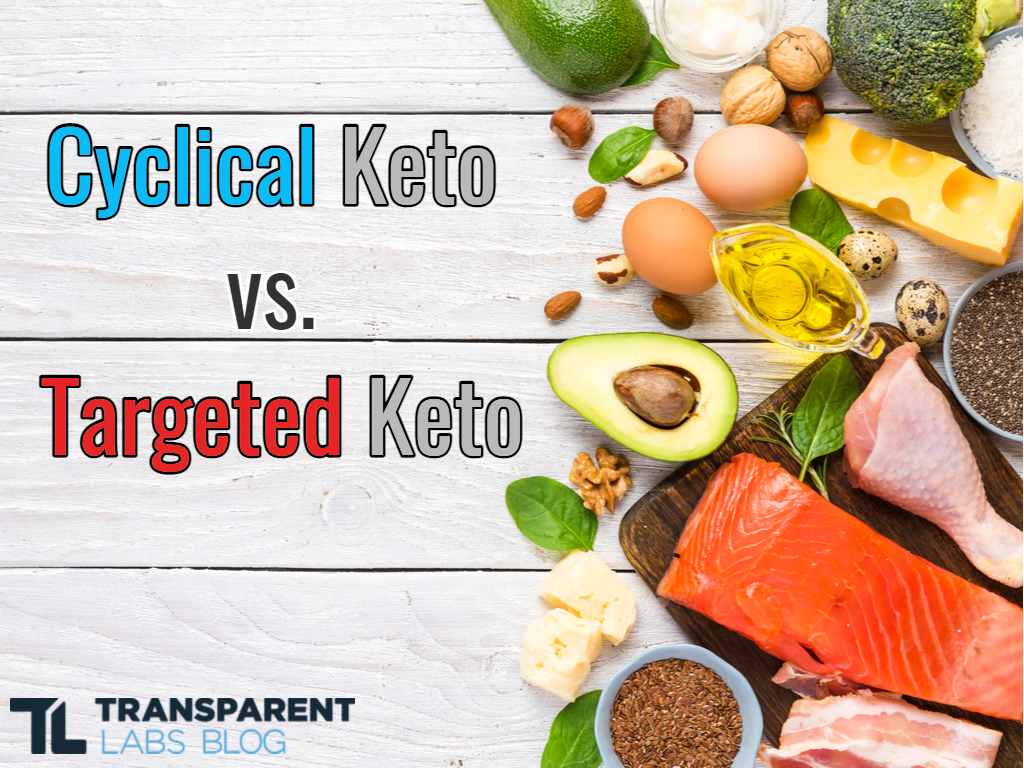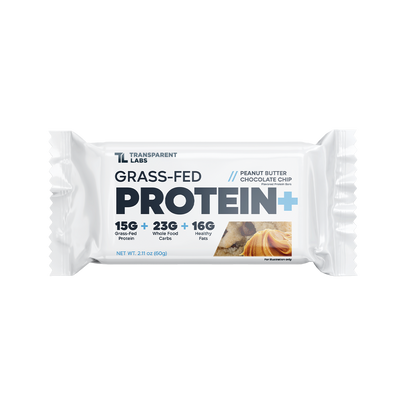Targeted vs. Cyclical Ketogenic Diet: Which Is Right for You?

Cyclical Ketogenic Diet vs. Targeted Ketogenic Diet: Everything You Need to Know
The cyclical ketogenic diet, or "CKD," is a modified ketogenic diet that rotates between a strict high-fat, low-carb ketogenic meal plan and lower-fat, higher carb intake (on respective days throughout the week). It's quite common for people to confuse the cyclical ketogenic diet and its close relative, the targeted ketogenic diet (TKD).
This article explains the benefits and basic steps of these two types of keto diets so you can decide if they are appropriate for your lifestyle and fitness goals.
What are the Three Different Types of Keto Diets?
Before diving into the specifics of the cyclical ketogenic diet and targeted ketogenic diet, let's get you up to speed on what the standard ketogenic diet (SKD) entails. An SKD is a very-low-carb, high-fat diet that causes the body to shift substrate metabolism primarily from glucose (i.e., sugar) to fats. As a result of this increase in fat metabolism, the liver produces more ketones (specifically, ketone bodies).
The typical macro breakdown (as a percentage of calorie intake) for a standard keto diet is:
- 70-75% fat
- 20-25% protein
- ≤5% carbs
The standard ketogenic diet is generally ideal for individuals that are ready to commit to a low-carb lifestyle so they can reap the benefits of ketosis. Naturally, you will need to eschew starchy and sugary foods, as well as monitor carbohydrate intake diligently.

The Targeted Ketogenic Diet (TKD)
This approach is much like a happy middle ground between a standard keto diet and having occasional meals with starchy carbs. For most people, a targeted keto diet will include a weekly high-carb meal before or after an intense workout (to help offset the increase in glycogen stores and maintain ketosis thereafter).
The Cyclical Ketogenic Diet (CKD)
Cyclical keto dieting is similar to a carb-cycling diet where you have periodic high-carb days. This keto diet variation is best suited for active people who find that the standard keto diet and targeted keto diet hinder athletic performance during high-intensity workouts. Regardless of your background and goals, it’s best to start with any of the keto diet types mentioned above before trying a cyclical ketogenic diet.
If you don’t make much progress, or you don’t perform well, then consider a CKD with one high-carb day per week (very active people may benefit from two high-carb days per week).
Determining How Many Grams of Carbs to Eat
Regardless of which keto diet variation you follow, start by calculating your macronutrient needs on a standard keto diet, then modify those needs based on the instructions below:
For a Targeted Ketogenic Diet:
- Training days—Follow standard keto diet macros and consume 30-50 g of carbohydrate with your pre-workout or post-workout meal (on your hardest training day)
- Rest days—Follow standard keto diet macros to get back into ketosis quickly
Note: If your recovery and energy are compromised, eat an additional carb-rich meal before or after your second hardest workout of the week.
For a Cyclical Ketogenic Diet:
- 1-2 High-Carb Days Per Week — Switch macros (as a percentage of total calories) to 30-40% carbs, 25-30% protein, and 30-35% fat
- Spread your carbohydrate intake out across multiple meals on high-carb days
- It’s generally best to eat carbs on days that you are very active (or the day before)
Potential Benefits of the Cyclical Keto Diet and Targeted Keto Diet
There isn't much research on cyclical or targeted keto, so the benefits are somewhat speculative. These keto diet variations are popular among athletes and gym-goers that perform high-intensity workouts, generally during a weight-loss phase. It's reasonable to assume that a cyclical keto diet would be better for these individuals than a strict keto diet since intermittent carb refeeds will increase muscle glycogen stores.
But what's so special about the keto diet, you ask?
Well, there are three distinct ketones/ketone bodies produced in the human body: Acetoacetate (AcAc), acetate (Ac), and beta-hydroxybutyrate (BHB). Here are some quick summaries of their roles:
- Acetoacetate: The initial ketone body produced from the oxidation (read: "burning") of fatty acids during fasting/carb restriction; acetoacetate serves as an alternative energy source when glucose is limited.
- Acetone: A metabolite of acetoacetate responsible for the fruity smell of breath and body odor during ketosis and extensive fasting. This ketone body is rapidly excreted in the urine and through respiration.
- Beta-Hydroxybutyrate (BHB): This ketone is formed from acetoacetate and ketogenic amino acids (e.g., branched-chain amino acids) and provides most of the health benefits of ketosis. BHB is the body's primary ketone fuel source once you're "fat-adapted."
Normally, we only produce a relatively small amount of these ketones. But when you restrict carbs and increase fat intake, the ketone levels increase significantly. Eventually, this leads to a state of nutritional ketosis.

Research on the ketogenic diet dates back to the early 20th century when physicians noticed positive results in epileptic patients that restricted their sugar/carbohydrate intake [1]. At the time, doctors and scientists knew very little about the potential health benefits of ketones produced in the body.
Notably, being in ketosis appears to have favorable effects on appetite regulation, which is great for weight loss [2]. Like glucose, ketone bodies are a viable energy source for the brain and muscle tissue, including skeletal muscle and the heart. However, ketones have the advantage of being less demanding of the pancreas — which secretes insulin in response to carb-rich meals.
The more we rely on sugary foods, the harder the body has to work to control blood sugar levels. Eventually, cells become less responsive to the physiological effects of insulin (i.e., shuttling glucose from the bloodstream into cells), leading to chronic hyperglycemia and insulin resistance.
Is Insulin "Bad" for Weight Loss?
Long-term elevation of insulin levels is a culprit of type-2 diabetes, cardiovascular disease, inflammatory conditions (e.g., arthritis), and obesity [3]. Modern food processing — which relies heavily on added sugars and refined grains — is partly to blame for the rapid increase in these disease states.
Yet, researchers rightfully contend that the hype behind keto diets is outpacing the evidence [4]. The keto diet is not "magic," nor does being "fat-adapted" circumvent the immutable laws of thermodynamics; weight loss boils down to consuming fewer calories than you burn, regardless of macronutrient proportions.
It's also important to note that insulin is not intrinsically "bad" or "unhealthy." Insulin is an essential peptide hormone that everyone needs for proper function and longevity (hence, type-1 diabetics have to inject insulin daily). The pancreas still produces some insulin on the keto diet since certain amino acids increase insulin secretion, which subsequently facilitates muscle tissue repair.
Insulin tends to get a bad rap since it is problematic in excess (like most things in life). Heck, even ketones in excess can be unhealthy by making the blood highly acidic — a condition known as ketoacidosis. Don't worry, though; ketoacidosis is extremely rare when following any type of keto diet.
Cyclical Keto Diet vs. Targeted Keto Diet: Which is Best?
Numerous clinical studies discuss the merits and applications of a strict keto diet [5]. Unfortunately, virtually none of these studies focus specifically on niche types of keto diets, such as the cyclical keto diet and targeted keto diet. As such, it's unclear if we can extrapolate the findings of research on a standard ketogenic diet to the cyclical and targeted keto diet subtypes.
Regardless, there is no shortage of anecdotes from gym-goers and fitness enthusiasts who swear by cyclical and targeted keto diets, particularly for improving weight loss and muscle mass retention without compromising athletic performance. Ultimately, the only way to find out if these keto diet variations can help you lose weight and cut body fat is to give them a shot.
In most cases, it's prudent to start with a standard keto diet to allow your body to get into deep ketosis. Then, you can transition to a cyclical keto diet or targeted keto diet and see how you respond. Check out our Macro and Calorie Calculator to get started!









